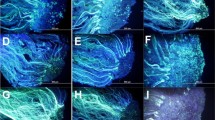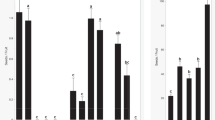Summary
The frequency of aborted fruits and the changes and abnormalities that occur during the embryo development in intraspecific crosses of sweet-potato Ipomoea batatas (2n=6x=90) and interspecific crosses between I. batatas and I. trifida (2n=2x=30) were investigated in order to study the causes of the low seed production. Three genotypes of I. batatas and 18 genotypes of I. trifida were intermated. The frequency of aborted fruits was below 25% in the intraspecific crosses and over 90% in the interspecific crosses. Paraffin sections were used to examine the developmental stages of fruits and seeds. Embryos in different developmental stages were observed to determine the stage of abortion. These observations permitted the identification of developmental stages of embryo rescue in interspecific crosses. There were no significant differences in the frequency of embryo abortion before the early globular stage among female sweet-potato progenitors for the intraspecific and interspecific crosses. The frequency of the late occurrence of embryo abortion (when embryo abortion occurs after the pre-globular stage) was higher in interspecific crosses (19.1%) than in intraspecific crosses (5.5%). The frequency of the late occurrence of embryo abortion in interspecific crosses was higher at the globular stage (9.6%) than at the heart stage (4.3%). Providing that embryo rescue is conducted in interspecific crosses, the estimated number of potentially viable embryos could be increased: 30 times with embryos at the globular stage; 20 times with embryos at the heart stage; and 11 times if embryos at the torpedo stage were used for the rescue with respect to the seed set. The results suggested that the appropriate time for embryo rescue in interspecific crosses is at the globular stage. If embryos could be rescued at the globular stage, it would be possible to increase the number of surviving embryos up to 30 times in interspecific crosses and 0.02 times in intraspecific crosses with respect to natural conditions without embryo rescue.
Similar content being viewed by others
References
Ahn CS, Hartmann RW (1978) Interspecific hybridization between mung bean (Vigna radiata L. Wilczek) and adzuki bean (V. angularis Willd. Ohwi & Ohashi). J Am Soc Hort Sci 103:3–6
Blakeslee AF, Belling J, Farnham ME (1923) Inheritance in tetraploid Daturas. Bot Gaz 76:329–373
Cooper DC, Brink RA (1945) Seed collapse following matings between diploid and tetraploid races of Lycopersicon pimpinellifolium. Genetics 30:376
Freyre R, Iwanaga M, Orjeda G (1991) Use of Ipomoea trifida (H.B.K.) G. Don. germ plasm for sweet potato improvement. 2. Fertility of synthetic hexaploids and triploids with 2n gametes of I. trifida, and their interspecific crossability with sweet-potato. Genome 34:209–214
Johnston SA, den Nijs TPM, Peloquin SJ, Hanneman RE Jr (1980) The significance of genic balance to endosperm development in interspecific crosses. Theor Appl Genet 57:5–9
Jones A, Kobayashi M (1969) Interspecific hybrids of Ipomoea pescaprae and I. crassicaulis. Bot Gaz 130:264–266
Jorgensen CA (1928) The experimental formation of heteroploid plants in the genus Solanum. J Genet 19:133–211
Katayama Y (1933) Crossing experiments in certain cereals, with special reference to different compatibility between the reciprocal crosses. Mem Coll Agric, Kyoto Imp Univ 27:1–75
Kihara H, Nishiyama I (1932) Different compatibility in reciprocal crosses of Avena, with special reference to tetraploid hybrids between hexaploid species. Jpn J Bot 6:245–305
Kobayashi M (1978) Sweet potato breeding method using wild relatives in Japan. In: Symposium on Tropical Agriculture Research, October 1977, Tsukuba, Ibaraki, Japan. Ministry of Agriculture, Forestry and Fishery, Japan
Kobayashi M (1981) Origin and variety differentiation in sweetpotato (in Japanese). Yokenda, Tokyo. Rec Adr Plant Breed 22:107–103
Kokubu T, Murata T, Endo F (1982) Anatomical observations on the fertilization and embryogenesis in sweet potato, Ipomoea batatas (L.) Lam.. Jpn J Breed 32:239–246
Nishiyama I, Inomata N (1966) Embryological studies on crossincompatibility between 2 × and 4 × in Brassica. Jpn J Genet 41:27–42
Nishiyama I, Yabuno T (1979) Triple fusion of the primary endosperm nucleus as a cause of interspecific cross incompatibility in Avena. Euphytica 28:57–65
Orjeda G, Freyre R, Iwanaga M (1991) Use of Ipomoea trifida germplasm for sweet potato improvement. 3. Development of 4 × interspecific hybrids between Ipomoea batatas (L.) Lam. (2n=6x=90) and I. trifida (H.B.K.) G. Don. (2n=2X=30) as storage-root initiators for wild species. Theor Appl Genet 83:159–163
Phillips GC, Collins GB, Taylor NL (1982) Interspecific hybridization of red clover (Trifolium pratense L.) with T. sarosiense Hazsl. using in vitro embryo rescue. Theor Appl Genet 62:17–24
Randolph LF (1935) Cytogenetics of tetraploid maize. J Agric Res 50:591–605
Saunas R (1988) Cultive in vitro de embriones de camote (Ipomoea batatas Lam). Thesis, La Molina National Agricultural University, Lima (available at the International Potato Center)
Sharma DR (1980) Interspecific hybridization in genus Solanum: A cross between S. melongena and S. khasianum through embryo culture. Z Pflanzenzücht 85:248–253
Smith JA, Desborough SL (1986) An interpretation of genomic balance in seed formation in interspecific hybrids of Solanum. Theor Appl Genet 72:346–352
Thompson WP (1930) Shrivelled endosperm in species crosses in wheat, its cytological causes and genetical effects. Genetics 15:99–113
Torres F (1985) Anatomia comparativa de estructuras vegetativas de especies cultivadas de papa desarrolladas en dos ambientes contrastantes. Thesis, La Molina National Agricultural University, Lima, (available at the International Potato Center)
Wakakuwa S (1934) Embryological studies on the different seed-development in reciprocal interspecific crosses of wheat. Jpn J Bot 7:151–185
Author information
Authors and Affiliations
Additional information
This research was initiated during sabbatical of M.I. at the Asian Vegetable Research and Development Center (AVRDC) in Taiwan
Rights and permissions
About this article
Cite this article
Mont, J., Iwanaga, M., Orjeda, G. et al. Abortion and determination of stages for embryo rescue in crosses between sweet-potato, Ipomoea batatas Lam. (2n=6x=90) and its wild relative, I. trifida (H. B. K.) G. Don. (2n=2x=30). Sexual Plant Reprod 6, 176–182 (1993). https://doi.org/10.1007/BF00228646
Issue Date:
DOI: https://doi.org/10.1007/BF00228646




